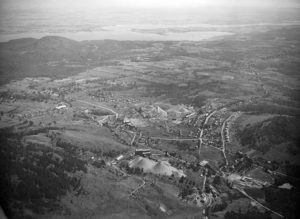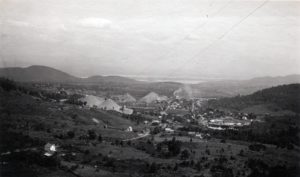Andebit et beaqui corendit, ut quostes esciendion re dit ad et prae parion es quia quas alibus sam, omnim faciden ducipidiat arum autem nobis enis es voat

15. Belfry Mountain Historic Fire Tower
The Uniqueness of Adirondack Iron
Listen to the Site 15 Iron Story Audio Narration

This fire tower offers a spectacular view of tailings piles, the center of mining operations, Lake Champlain to the east, and the Adirondack High Peaks to the west. From the discovery of iron ore in the middle of the 18thcentury and the beginning of commercial mining in the early 1820s through the takeover by Republic Steel in 1938, more than 33 million tons of iron ore were taken out of the ground by all mining efforts, from individuals mining their own properties to industrial powerhouses of the late-19th century. From 1870 to 1938, Witherbee, Sherman and Company and Port Henry Iron Ore Company were responsible for more than 31,500,000 tons of that iron ore, some of the best iron ore in the world.

Of course, these two were not the only iron companies in Moriah—nor were they the only miners of local iron. Just along the southern portion of the Boquet River were dozens of small iron ore beds. The iron mined from these beds was sent to various Port Henry furnaces for processing. According to historian Richard Sanders Allen, between 1822 and 1940, there were eight distinct blast furnaces operating in the village of Port Henry alone.
Bloomery smelting, in particular, was a major element of the regional economy—reaching a peak in 1882, when over 48,000 tons of bloomery iron was made in the Adirondacks. Although the total production was a small part of the total output of iron in the United States, the Adirondack industry had a national significance. In the mid-1800s, the quality of the iron here was considered superior. For example, in 1846, while searching for metal suitable for bridge wire, it was determined that Champlain iron was superior to Norway iron (then considered the best wrought iron available). The Adirondack region supplied 84 percent of the US output of charcoal-iron blooms in 1880. That’s in part because of the forge efficiency and iron quality: At a typical Adirondack forge, 2,000 pounds of iron could be made from 4,000 pounds of ore (prepared by crushing and washing) and 5,400 pounds of charcoal with 1.25 man-days of labor. This was far more efficient than the most sophisticated bloomeries of Europe, where the same amount of iron required 6,240 pounds of ore, 7,200 pounds of charcoal, and 4.5 days of man labor. The technical superiority of the Adirondack bloomeries came from improvements in the process worked out in the U.S. before 1850. One of the most important of these was the use of a hot blast to improve the fuel efficiency of the process. And yet, we’ll discover that is was this superiority that ironically also led to the demise of the region’s iron industry.
Travel Tools

Continuing on Fisher Hill Road, you will turn hard left onto County Highway 7C (Dalton Hill Road) at the first intersection. Soon after, you’ll see a small DEC sign marking the start of the hike near a metal gate on your right. A trail leads to a fire tower that affords a 360-view of a chain of tailings piles, each from a different mine, spread along the slope down to Lake Champlain. A more modern addition to the scenery is the enormous cell phone towers that loom over all. This is an easy, quick hike—0.35 mile with an overall elevation gain of just 137 feet. At 1,840 feet, Belfry Mountain is small, however, the views are spectacular. The trail, a gravel road, is a service road for the communication towers. You can easily miss the trailhead if you’re not paying attention. There is a pull off near the sign.
If you’re afraid of heights or just want to climb the Belfry tower vicariously, watch this YouTube video by Ticonderoga resident Tonya Whitford Condon: https://youtu.be/_4itgUAY6kg
The Moriah Chamber of Commerce is promoting four local CATS (Champlain Area Trails) with the “Moriah Challenge,” where hikers strive to complete all four hikes: Belfry Mountain Trail, Big Hollow/Coot Hill Trail, Cheney Mountain Trail, and Crowfoot Pond Trail. Anyone who successfully completes the challenge will receive a commemorative embroidered patch. For more info, you can email [email protected].
Learn More
First-Hand Accounts
“It seems to be of mushroom growth. The churches, houses, and public buildings are built anywhere and everywhere, back to back, sides to front, at all angles to the roads or streets, and with the carelessness of structures temporary. The experience of a decade has shown the villagers that at any moment it may become necessary to seek a living elsewhere, which has bred a constant disregard of solidity, comfort, and neatness. There is a grimness and roughness over the whole place, and not even the gorgeous summers of the mountain can hide them…. The traveler, after drinking in the beauties of the view which it offers—a slip of Champlain and the mountains of Vermont in the distance—leaves it without regret, glad that the grade to Port Henry permits him to fly down to the mountain within the hour.” -Reverend John Talbot Smith, visited Mineville in 1884 as part of his research for his book, A History of the Diocese of Ogdensburg


